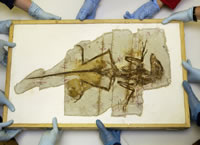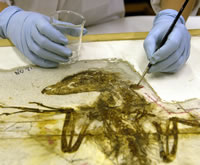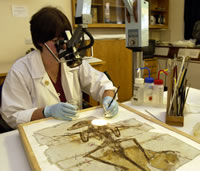|
In
early May 2002, two NHM staff went to China to collect the Liaoning
fossils and escort them back to London. Once here, Museum conservators
and staff from The Geological Museum of China worked together to
conserve these precious fossils for future generations to study
and enjoy. The work was divided into four stages:
Stage
1: Condition survey
Each specimen is carefully examined and photographed. Once its condition
has been assessed and recorded, the appropriate conservation treatment
can be applied.
Stage
2: Conservation work
Some specimens are well preserved and don't require any additional
conservation. However, some show evidence of contamination by materials
such as paint and old adhesives, which must be removed. Techniques
used on the specimens ranged from gentle brushing to the application
of solvent gels. Some of the larger cracks need filling with reversible
gap fillers to help stabilise the specimens.
Stage
3: Recording treatment
A record is made at every stage of treatment and all chemicals used
are listed. This 'treatment history' of a specimen, along with the
condition report, is a very useful reference for anyone else working
on the specimen in the future, rather like a patient's medical notes.
Stage
4: Correct installation
Conservation does not stop once the specimen has been treated. The
environment in which it is housed is also very important for its
future welfare. If the air is too dry or humid the specimens could
crack and warp. If the light is too strong, the colours on the surface
may alter and any chemicals applied to the surface could deteriorate.
Conservators are therefore consulted on the display case design,
lighting and atmospheric environment prior to installation in a gallery.
|



